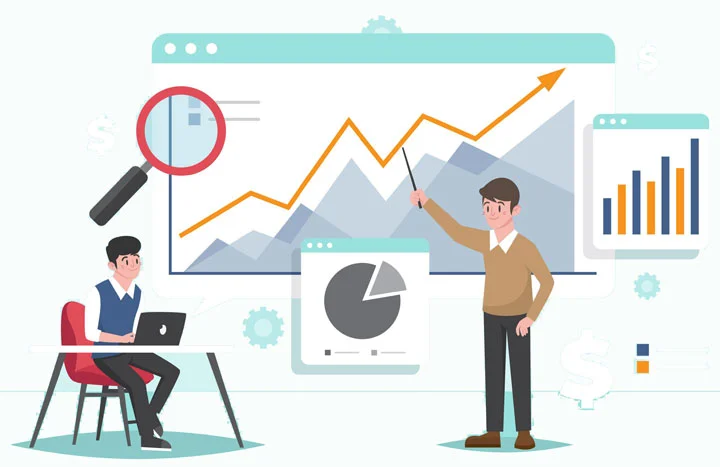Learn from Curated Curriculums developed by Industry Experts
Data Analysis Course Curriculum
1. What is an Application?
2. Types of Applications
3. Web Application Fundamentals
4. Web Technologies: (List key technologies and their roles)
Frontend: HTML, CSS, JavaScript, React
Backend: Python, Java, Node.js
Databases: SQL (MySQL, PostgreSQL), NoSQL (MongoDB).
5. Software Development Life Cycle (SDLC)
Phases: Planning, Analysis, Design, Implementation (Coding), Testing, Deployment, Maintenance.
6. Application Development Methodologies
Agile: Core principles, Scrum, Kanban
Waterfall
1. What is Data
2. Types of Data
3. Data Storage
4. Data Analysis
5. Data Engineering
6. Data Science
1. The Importance of Computing Power
2. Key Computing Technologies:
CPU (Central Processing Unit)
GPU (Graphics Processing Unit)
3. Cloud Computing:
What is the Cloud?
Cloud Service Models:
IaaS (Infrastructure as a Service)
PaaS (Platform as a Service)
SaaS (Software as a Service)
1. What is Artificial Intelligence (AI)?
2. How AI Works?
3. Key Concepts:
Machine Learning (ML)
Deep Learning (DL)
4. Generative AI:
What is Generative AI?
Examples: Large Language Models (LLMs), image generation models.
5. AI in Everyday Learning
1. Customer Relationship Management (CRM)
2. Human Resource Management Systems (HRMS)
3. Retail & E-Commerce
4. Healthcare
Overview of Analytics and Data Analysis Tools Suite
Career Opportunities and Job Roles in Data Analysis
Data Analysis Data Analyst (PL 300) Certification Overview
Introduction to AI Visuals and Features in Data Analysis
Understanding the Data Analysis Ecosystem and Architecture
Data Sources and Types for Data Analysis Reporting
Data Analysis Design Tools and Desktop Tool Installation
Exploring Data Analysis Desktop Interface: Data View, Report View, and Canvas
Visual Interaction Techniques in Reports
Using Slicers for Dynamic Report Filtering
Managing Report Pages and Visual Sync Limitations
Implementing Grouping and Binning in Reports
Creating and Utilizing Hierarchies for Drill-Down Reports
Introduction to Power Query M Language
Basic Data Transformations in Power Query
Understanding Query Duplication and Grouping
Overview of Data Analysis Cloud Components and App Workspaces
Creating and Managing Reports and Dashboards in Data Analysis Cloud
Sharing, Subscribing, and Exporting Reports in Data Analysis Cloud
Understanding the Importance of DAX in Data Analysis
Learning Basic DAX Syntax, Data Types, and Contexts
Simple Measures and Calculations with DAX
Accessing Big Data Sources and Azure Databases
Advanced Filtering Techniques and Utilizing Bookmarks
Implementing Various Chart Types and Map Visuals
Deep Dive into Advanced Data Cleaning and Preparation Techniques
Implementing Parameter Queries for Dynamic Data Loads
Creating and Managing Parameters in Power Query
Configuring and Managing Gateways for Data Refresh
Utilizing Workbooks and Excel Online with Data Analysis Cloud
Creating and Managing Data Analysis Apps
Implementing Quick Measures and Advanced Calculations
Data Modeling and Relationship Management in DAX
Mastering Variables and Dynamic Expressions in DAX
Advanced DAX Functions for Time Intelligence
Implementing Row Level Security (RLS) with DAX
Utilizing DAX for Custom Analytics and Reporting
Configuring Data Analysis Report Server
Understanding Data Analysis Administration and AI Features
Managing Security and Administration in Data Analysis
Implementing Cloud and Server Deployments
Custom Visualizations and Integration with REST APIs
Project Phases: From Basic Report Design to SME Level Deployments
Resume Preparation and Mock Interviews
Topics:
Introduction to Excel: Interface, Basic Operations, and Managing Worksheets
Fundamental Data Operations: Sorting, Filtering, and Conditional Formatting
Basic Formulas and Functions: Sum, Average, Logical Functions (IF, AND, OR), and Text Functions (LEFT, RIGHT, CONCATENATE)
Topics:
Advanced Data Management: Data Validation, Advanced Filtering, and Named Ranges
Creating and Managing Tables for Efficient Data Analysis
Introduction to Data Visualization: Creating and Customizing Charts (Bar, Line, Pie), and Using Sparklines
Topics:
Comprehensive Guide to PivotTables: Creating, Customizing, Slicers, and Timelines
Basic to Advanced PivotTable Techniques: Grouping Data, Calculated Fields
Data Cleanup Techniques: Removing Duplicates, Text to Columns, Flash Fill
Topics:
Mastering Lookup Functions: VLOOKUP, HLOOKUP, XLOOKUP
Introduction to Power Query for Data Transformation and Cleaning
Power Pivot and DAX Basics: Creating Data Models, Introduction to DAX Formulas for Data Analysis
Topics:
Automating Tasks with Macros and an Introduction to VBA for Custom Functions
Advanced Chart Techniques and Creating Interactive Dashboards
Workbook Protection, Sharing Workbooks for Collaboration, Documenting and Auditing Workbooks
Topics:
Introduction to Databases and SQL: Understanding relational databases and the role of SQL.
SQL Syntax Overview: Keywords, statements, and clauses.
Basic SQL Commands: `SELECT`, `FROM`, `WHERE`, and `ORDER BY`.
Filtering Data: Using conditions to retrieve specific data (`AND`, `OR`, `NOT`).
Topics:
Understanding Table Relationships: Primary keys, foreign keys, and the importance of relationships in databases.
Join Operations: `INNER JOIN`, `LEFT JOIN`, `RIGHT JOIN`, and `FULL JOIN`.
Subqueries and Nested Queries: Using subqueries in the `SELECT`, `FROM`, and `WHERE` clauses.
Aggregating Data: Using `GROUP BY` and aggregate functions (`COUNT`, `SUM`, `AVG`, `MIN`, `MAX`).
Topics:
Data Manipulation Commands: `INSERT`, `UPDATE`, `DELETE`.
Managing Tables: Creating and altering tables (`CREATE TABLE`, `ALTER TABLE`, `DROP TABLE`).
Advanced Filtering Techniques: Using `LIKE`, `IN`, `BETWEEN`, and wildcard characters.
Working with Dates and Times: Understanding and manipulating date and time data.
Topics:
Advanced SQL Functions: String functions, mathematical functions, and date functions.
Window Functions: Overviews of `ROW_NUMBER`, `RANK`, `DENSE_RANK`, `LEAD`, `LAG`, and their applications.
Query Performance Optimization: Indexes, query planning, and execution paths.
Common Table Expressions (CTEs): Writing cleaner and more readable queries with `WITH` clause.
Topics:
Analytical SQL for Reporting: Building complex queries to answer analytical questions.
Pivoting Data: Transforming rows to columns (`PIVOT`) and columns to rows (`UNPIVOT`).
Data Warehousing Concepts: Introduction to data warehousing practices and how they apply to SQL querying.
Integrating SQL with Data Analysis Tools: Connecting SQL databases with tools like Excel, Data Analysis, and Python for deeper data analysis.
1. Introduction to Python
Overview of Python's history, key features, and comparison with other languages.
Setting up the Python environment, writing your first program. 2. Core Programming Concepts
Variables, data types, conditional statements, loops, control flow.
Introduction to strings, string manipulation, and basic functions.
Topics:
1. Deep Dive into Collections
Understanding lists, tuples, dictionaries, sets, and frozen sets.
Functions, methods, and comprehensions for collections.
2. Functional Programming in Python
Exploring function arguments, anonymous functions, and special functions (map, reduce, filter).
3. Object-Oriented Programming (OOP)
Classes, objects, constructors, destructors, inheritance, polymorphism.
Encapsulation, data hiding, magic methods, and operator overloading.
Topics:
1. Mastering Exception Handling
Exception handling mechanisms, try & finally clauses, user-defined exceptions.
2. File Handling Essentials
Basics of file operations, handling Excel and CSV files.
3. Database Programming
Introduction to database connections and operations with MySQL.
Topics:
1. Getting Started with Flask
Setting up Flask, creating simple applications, routing, and middleware.
2. Exploring Django
Introduction to Django, MVC model, views, URL mapping.
Topics:
1. Automation and Scripting
Enhancing file handling, database automation, and web scraping with BeautifulSoup.
2. GUI Development with TKinter
Basics of TKinter for developing desktop applications.
3. Version Control with Git
Managing projects with Git, understanding repository management, commits, merging, and basic Git commands.
Topics:
Cloud Computing Fundamentals: Overview of cloud service models (IaaS, PaaS, SaaS) and deployment models (public, private, hybrid).
Basics of DevOps: Understanding the DevOps culture, practices, and its significance in cloud environments.
Data on the Cloud: Exploring cloud storage solutions, databases, and big data services provided by major cloud providers (AWS, Azure, Google Cloud).
Introduction to Infrastructure as Code (IaC): Concepts and tools for managing infrastructure through code.
Topics:
Cloud Storage Solutions: Differences between object storage, file storage, and block storage. Use cases for each.
Cloud Databases: Overview of relational and NoSQL database services in the cloud (e.g., AWS RDS, Azure SQL Database, Google Cloud Firestore).
Data Warehousing and Big Data Solutions: Introduction to cloud-based data warehousing services (e.g., Amazon Redshift, Google BigQuery, Azure Synapse Analytics).
Data Migration to Cloud: Strategies and tools for migrating data to cloud environments.
Topics:
Automated Data Pipelines: Designing and implementing automated data pipelines using cloud services.
Continuous Integration and Continuous Delivery (CI/CD) for Data: Applying CI/CD practices to data pipeline development, including version control, testing, and deployment strategies.
Monitoring and Logging: Tools and practices for monitoring cloud resources and data pipelines, understanding logs and metrics for troubleshooting.
Infrastructure as Code (IaC) for Data Systems: Using IaC tools (e.g., Terraform, CloudFormation) to provision and manage cloud data infrastructure.
Topics:
Serverless Data Processing: Leveraging serverless architectures for data processing tasks (e.g., AWS Lambda, Azure Functions).
Containerization and Data Services: Using containers (e.g., Docker, Kubernetes) for deploying and scaling data applications and services in the cloud.
Machine Learning and AI in the Cloud: Introduction to cloud-based machine learning services and integrating AI capabilities into data pipelines.
Data Analytics and Visualization: Tools and services for analyzing and visualizing data directly in the cloud (e.g., Amazon QuickSight, Google Data Studio, Data Analysis on Azure).
Topics:
Overview of Generative AI: What it is, its capabilities, and key differences from traditional AI/ML.
Introduction to AI Agents: Defining AI agents, their architectures, and how they function.
Use cases and applications of GenAI and AI Agents in data analysis.
Ethical implications and responsible use of GenAI and AI Agents.
Topics:
Understanding foundational GenAI models:
- Large Language Models (LLMs) like GPT, BERT, etc.
- Diffusion models (for image generation)
Generative Adversarial Networks (GANs)
Training and fine-tuning GenAI models
Prompt engineering for effective GenAI outputs
Evaluating the quality and accuracy of generated data
Topics:
Architectural patterns of AI agents (e.g., reactive, deliberative, hybrid)
Components of an AI agent: perception, decision-making, action
Frameworks and tools for building AI agents
Autonomous decision-making and planning in AI agents
Integrating AI agents with data pipelines and platforms
Topics:
Using GenAI for data synthesis and augmentation: generating synthetic data for various purposes.
Applying GenAI for data understanding: summarizing, paraphrasing, and explaining complex datasets.
AI Agents for automated data cleaning and preparation
Developing AI Agents for interactive data exploration and analysis
Integrating GenAI and AI Agents with data visualization tools.
Topics:
Developing AI-powered data analysis tools and dashboards
Utilizing GenAI for predictive modeling and forecasting
Implementing AI Agents for real-time data analysis and reporting.
Case studies and practical examples of GenAI and AI agents in different industries.
Future trends and emerging research in GenAI and AI Agents for data analysis.
Deploying and managing GenAI models and AI agents in production.
Introduction to Generative AI
1. What is Generative AI?
2. Key Applications:
Text (ChatGPT, Claude, LLaMA)
Images (DALL·E, MidJourney, Stable Diffusion)
Audio (Music Generation, Voice Cloning)
Code (GitHub Copilot, Cursor)
3. Evolution of GenAI:
Rule-Based → Deep Learning → Transformers
GANs vs. VAEs vs. LLMs
1. Effective Prompt Design
Instruction-Based, Few-Shot, Zero-Shot
2. Advanced Techniques:
Chain-of-Thought (CoT) Prompting
Self-Consistency & Iterative Refinement
Hands-on:
Optimizing prompts for GPT-4, Claude, LLaMATransformer Architecture
1. Why Transformers? (Limitations of RNNs/LSTMs)
2. Key Components:
Self-Attention & Multi-Head Attention
Encoder-Decoder (BERT vs. GPT)
3. Evolution: BERT → GPT → T5 → Mixture of Experts
4. Large Language Models (LLMs)
5. Pre-training vs. Fine-tuning
6. Popular Architectures:
GPT-4, Claude, Gemini, LLaMA 3
BERT (Encoder-based) vs. T5 (Text-to-Text
Introduction to AI Agents
1. What are AI Agents?
2. vs. Traditional AI:
3. Applications:
AI Agent Frameworks
1. CrewAI (Multi-Agent Collaboration):
2. n8n (Workflow Automation):
Designing AI Agents
CrewAI + n8n: Automating Business Workflows
Multi-Agent Systems: Collaboration & Specialization
Real-World Applications
Case Studies:
AI Customer Support Agents
tools & platforms
Our Trending Courses
Our Trending Programs
Upcoming Batch Schedule
Week Day Batches
(Mon-Fri)
25th Sept 2023
Monday
8 AM (IST)
1hr-1:30hr / Per Session
Week Day Batches
(Mon-Fri)
27th Sept 2023
Wednesday
10 AM (IST)
1hr-1:30hr / Per Session
Week Day Batches
(Mon-Fri)
29th Sept 2023
Friday
12 PM (IST)
1hr-1:30hr / Per Session
























